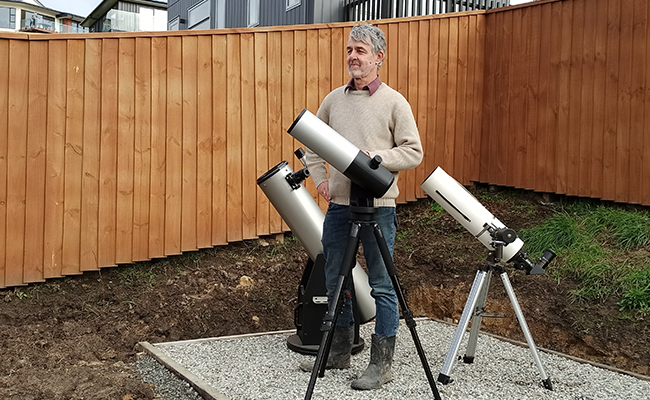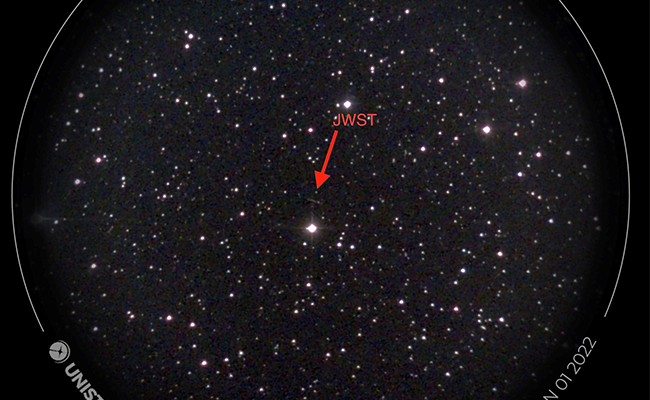 John Pickering regularly hosts events in his Christchurch garden where people can use his telescopes to get a little closer to the mysteries of space.
John Pickering regularly hosts events in his Christchurch garden where people can use his telescopes to get a little closer to the mysteries of space.
Off-Campus profiles the diverse and inspiring out-of-office pursuits of Otago staff. This week, Department of Medicine research professor and keen astronomer John Pickering
Professor John Pickering can trace his interest in astronomy a long way back.
“Probably since my mother sang Twinkle, Twinkle Little Star to me,” he laughs.
While he chose a career in physics, the stars have always been his passion. As part of a global team he helps track asteroids such as the wonderfully named “God of chaos” which is due to fly within a whisker of Earth on its next pass.
Closer to home, John regularly hosts events in his Christchurch garden where mind-blown teenagers and awed older folk can use his telescopes to get a little closer to the mysteries of the galaxy.
“I think I'd do just about anything to get people to look up,” he says.
“I showed my parents' 89-year-old neighbour with macular degeneration Omega Centauri, a globular cluster of 10 million stars. It's nice and bright and she said, 'That's magic'. And she's been telling her children and nieces and nephews and everybody she can find about it.”
“When I get a bunch of older kids and teenagers, I should have a swear jar so I can pay for the telescope.”
As a student, John studied some astronomy in passing but ultimately elected to pursue a physics doctorate and was part of the team that pioneered the use of lasers to remove birthmarks at St George's Hospital in Christchurch.
Now a largely charity-funded research professor, his interests include optimising the use of biomarkers for diagnosis, clinical pathway development and translational research in acute care.
While helping drive technological advances in healthcare, John was also witnessing some leaps that would transform amateur astronomy.
One was the development of the Unistellar telescope, a portable device which allows backyard astronomers to see deep sky objects. (John was an early backer and is now a voluntary Unistellar ambassador).
Another was the growth of citizen science, where amateur astronomers around the world can collaborate on projects by feeding information to large databases such as the one run by SETI.
 As the James Webb Space Telescope made its journey through space, John and 50 other citizen scientists were observing it as part of a SETI project.
As the James Webb Space Telescope made its journey through space, John and 50 other citizen scientists were observing it as part of a SETI project.
These advances were turbo-charged by the successful Christmas 2021 launch of the James Webb Space Telescope which is giving us unprecedented views of the universe from its location 1.5 million km from Earth.
As the telescope made its journey through space, John and 50 others were observing it as part of a SETI project which resulted in his first contributing author credit in an astronomy publication.
The citizen science teams also monitor potentially hazardous asteroids, comets and help confirm the presence of planets around other stars.
“There will be a campaign that a particular comet or asteroid is heading our way. We might measure it and can get pictures if it's visible and then send the data off to SETI. And they will build up an improved knowledge of its orbit, which is kind of important if it's going to get close next time around.
“One of the ones I did is an asteroid called Apophis, which means God of chaos. Next time it comes round is in about 20-something years. They thought it had a 3% chance of hitting the earth which is quite high. The measurements have reduced that considerably but it will probably disturb a few satellites in the higher orbits.”
Because the Unistellar telescopes work by building a composite picture over time, eureka moments happen but come with a time delay of a few seconds for visual observations to a few days for science.
“I had my eureka moment when I observed my first exoplanet (a planet beyond our solar system) and got the data back. But it was too subtle to see live.”
John says it is the beauty of the universe and the historic importance of the stars to every culture that draws him to look outwards.
“The Māori and Polynesians were the greatest navigators there ever were because of the knowledge of the stars. Science took off because of astronomy and the telescope and seeing things that were different from Aristotelian perfect circles.
“Curiosity drives us as humans. The James Webb has the capacity to reveal not just further in the past about the universe, but more details about the nearest stars and planets, especially the holy grail for exoplanets which would be to detect oxygen.
“The very first planet they looked at, they saw some water in the atmosphere. There's a whole lot of mysteries about how the universe evolved. With a telescope you're always looking back in time - this one can look back even further.
